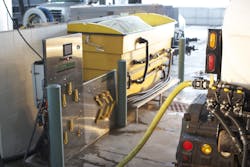Cranberry Township reduces rock-salt usage with automated brine maker
Faced with a common problem of bounce and scatter with traditional rock salt, Cranberry Township decided to investigate alternative ways to keep roads clear of snow and ice. Having only used pre-wetting applications with magnesium chloride when the weather dropped below 20 degrees Fahrenheit, this costly solution prompted their research into brine-making equipment.
During an extensive review of several different brine makers, they were introduced to the automated brine maker from Cargill Deicing Technology. The system, called AccuBrine, can produce approximately 5,000 gal of brine per hour at accurate salinity concentrations.
“We purchased the automated brine maker in 2012 and began using it that winter season,” said Bob Howland, manager of Cranberry Township’s streets and fleet.
Howland noted that multiple operators were trained to use the system and found the automated controls limited the amount of time needed to make brine. “We knew the most important element in the operation is salinity accuracy,” said Howland. “Our new brine maker accurately produced the right salt brine solution, which helped us reduce our rock salt usage.”
Because their trucks already had pre-wetting equipment, the township was able to make better use of the fleet by using the brine to pre-wet the salt at the spinner. “We were able to recognize a savings in rock-salt usage on all routes,” Howland said. “Our biggest savings were on two specific routes that used two demo spreaders. Both units carried 465 gal of liquid compared to our 100-gal tanks on our other trucks, and those spreaders demonstrated the greatest benefit of using the pre-wet salt brine.”
For convenience and increased speed, the brine is stored and loaded directly into trucks. “We load it directly into our trucks during production or into our 5,000-gal storage tank,” said Howland. “We also have a 5,000-gal blended tank with our 80/20 ratio of brine and magnesium chloride. Our magnesium chloride is stored in a 3,000-gal tank in a separate building about 150 ft away and the unit is able to easily pull the magnesium chloride from the tank and pump it into the blended tank.”
Creating custom blends allows the township to incorporate magnesium chloride when the temperature calls for it, and the brine maker helps Howland and his team make custom blends with ease.
“We are responsible for 125 miles of roads, which includes 298 cul-de-sacs,” Howland said. “The primary reasons we chose to purchase the brine maker were to reduce our salt usage, add moisture to rock salt for faster reaction time and help the environment.”
